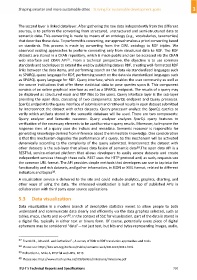Page 717 - Shaping smarter and more sustainable cities - Striving for sustainable development goals
P. 717
The second layer is linked data layer. After gathering the raw data independently from the different
sources, is to perform the converting from structured, unstructured and semi‐structured data to
semantic data. This converting is made by means of an ontology (e.g., vocabularies, taxonomies)
that describes these data. To perform this converting, our approach makes a priori converting based
on standards. This process is made by converting from the OWL ontology to RDF triples. We
observed existing approaches to perform converting only from structured data to RDF. The RDF
datasets are stored in a CKAN repository, which is made public and can be accessed via the CKAN
37
web interface and CKAN API . From a technical perspective, the objective is to use common
standards and techniques to extend the web by publishing data as RDF, creating well‐formatted RDF
links between the data items, and performing search on the data via standardized languages such
as SPARQL query language for RDF, performing search on the data via standardized languages such
as SPARQL query language for RDF. Query interface, which enables the user community as well as
the source institutions that offer these statistical data to pose queries upon it. This component
consists of an online graphical interface as well as a SPARQL endpoint. The results of a query may
be displayed as structured excel and RDF files to the users. Query interface layer is the sub‐layer
providing the open data, consisting of two components: SparQL endpoint and Query processor.
SparQL endpoint is the query interface of submission and retrieval results in open dataset submitted
by Interconnect the dataset with other datasets. Query processor analyze the SparQL queries to
verify which artifacts stored in the semantic database will be used. There are two components:
Query analyzer and Semantic reasoner. Query analyzer analyzes SparQL query features to
verification of the necessary elements to be used to return query results. Moreover, to improve the
response time of a query uses the indices and metadata. Semantic reasoner is responsible for
generating knowledge derived from inference about the immediate knowledge. One consideration
is that this mechanism degrades the performance of a query. So this mechanism will be activated
dynamically according to the complexity of the query submitted. Interconnect the dataset with
38
other datasets is the sub‐layer that allows data fusion of semantic data .The open data API is a
RESTful, service‐oriented platform that allows developers to easily access datasets and create
independent services through these calls. REST uses the HTTP protocol and, as such, requests use
the common URL format. The API provides simple methods that developers can use to tap into the
functionality and rich datasets, and gather information, in JSON or XML format, related to different
39
indicators and topics .
A visualization service is delivered to the site and could include analytics, graphics, charting, and
other ways of using the data. The enhanced visualization is built on top of published APIs in
collaboration with third party open source applications.
5.3 Data visualization
Data visualization is a modern branch of descriptive statistics meant to allow people to both
understand and communicate data clearly and efficiently via the data graphics selected, such as
40
tables, maps, charts and so on . In the context of SSC for visualization, part of the data is stored in
a digital file, typically in either text or binary form. Of course, potentially every piece of digital
ephemera may be considered "data"—not just text, but bits and bytes representing images, audio,
____________________
37 Franck M., Johan M. and Catherine F.; A survey of RDB to RDF translation approaches and tools.
38 Please see: http://lists.w3.org/Archives/Public/semantic‐web/2011Oct/0041.html.
39 Richardson L, Mike A, RESTful web APIs. 2013
40 Please see: http://www.math.yorku.ca/SCS/Gallery/milestone/milestone.pdf
ITU‐T's Technical Reports and Specifications 707

